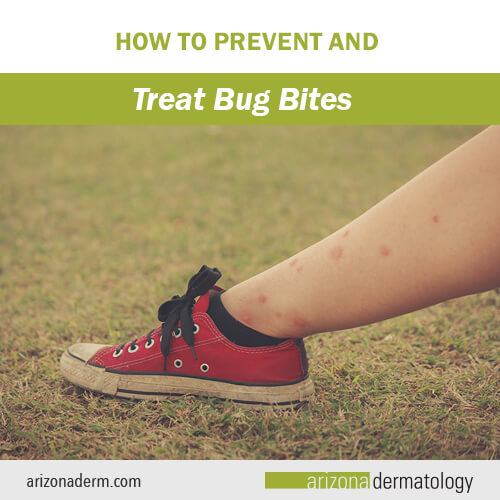 Outdoor living is part of what we love about Arizona. Unfortunately, it comes with a price—insects.
Outdoor living is part of what we love about Arizona. Unfortunately, it comes with a price—insects.
No one enjoys a prick or sting followed by a relentless itchy rash. And although most bug bites are harmless and resolve on their own, some insects can spread disease, and some people react more strongly to insect venom than others. Arizona is also home to critters like the bark scorpion and black widow spider, whose sting or bite can be life-threatening. Today we are going to cover dermatologist-recommended steps you can take to prevent and treat insect bites and stings.
Preventing Insect Bites and Stings
In Arizona, the biggest culprits include mosquitoes, scorpions, spiders, bees, wasps, fire ants, ticks, and chiggers. Here are prevention tips for avoiding getting stung or bitten.
Use Insect Repellent. To protect against mosquitoes and ticks, both of which can carry diseases, the American Academy of Dermatology recommends using an insect repellent containing a 20 to 30 percent DEET on exposed skin. Spray your clothing, too, making sure to follow the directions on the repellent. Don’t breathe in the spray. If using sunscreen first, wait until the sunscreen dries before applying the repellent.
Cover Up. If you are going to be out at night or hiking in the woods, cover up as much as possible with a long-sleeved shirt, pants, socks that cover your ankles, and closed-toed shoes. For additional protection, tuck your pants into your socks and tuck your shirt into your pants. Your outer layers of clothing can be pre-treated with an insect repellent containing Permethrin. Be sure to follow the directions carefully and wait at least two hours before wearing treated clothing.
Use a Net. If sleeping outdoors, use bed nets pre-treated with an insecticide.
Do a “Scorpion Check.” Scorpions are one insect that prefers to come indoors rather than stay outside. Check cribs and pull back the covers on your bed to check for dangerous bark scorpions hiding in your sheets. Shake out clothing that has been lying on the floor. Always shake shoes before putting them on.
Wear Shoes. Don’t go outside barefoot. Always wear proper foot protection, especially when walking in grass or wooded areas. Watch where you step or reach.
Treating Bug Bites and Stings
If you do get bitten or stung, most of the time these can be treated at home.
For painful bites or stings, take an over-the-counter pain medication like ibuprofen or acetaminophen. If a bee stinger remains in your skin, remove it by scraping your fingernail over it or using a piece of gauze. Never use tweezers as this may squeeze additional venom into your skin. Wash the area with soap and water.
For bites that itch, apply an ice pack to the itchy area. You can also use an over-the-counter anti-itch cream, such as hydrocortisone. An oral antihistamine may also help with symptoms.
To reduce swelling, apply an ice pack to the affected area.
To remove a tick, use tweezers. Sterilize the tip of the tweezers with rubbing alcohol and grasp the tick as close to the skin’s surface as possible. Pull upwards with a steady, even pressure. Do not twist, squeeze, or crush the tick, which can cause its head to break off and remain in your skin. If this happens, use tweezers to remove the remaining bug parts. If you cannot, see a dermatologist to have them removed. Keep the tick in a plastic bag in case you develop symptoms after the bite. Clean the bite with soap and water.
When to Seek Medical Attention
If any of the following occurs, go to the emergency room immediately.
Any Bite:
- Difficulty breathing
- A sensation of your throat closing
- Swollen lips, tongue, or face
- Chest pain
- A racing heartbeat that lasts more than a few minutes
- A headache
- Dizziness
- Vomiting
Ticks:
- A red, donut- or target-shaped rash that develops after a tick bite. (This could be a sign of Lyme disease.)
- A fever with a red or black, spotty rash that spreads. This could be a sign of Rocky Mountain spotted fever, a tick-borne bacterial infection, which requires immediate treatment.
Bees:
- If you or someone you know has been stung multiple times — particularly if he or she is a child.
Spiders:
- If a bite develops into an open sore or you see signs of necrosis (tissue death). This could be the result of a bite from the brown recluse
- If the bite comes from a black widow spider. These spiders have a shiny black body with long legs and a red hourglass shape on their belly. They are about 1 inch in length.
Scorpions
- If symptoms other than pain and tingling at the site occur after a bark scorpion sting; for example, muscle jerking, difficulty breathing, difficulty walking, excessive pain and numbness throughout the body.
For non-emergency concerns surrounding insect bites, call us for an appointment.


